by B.B. Pelletier
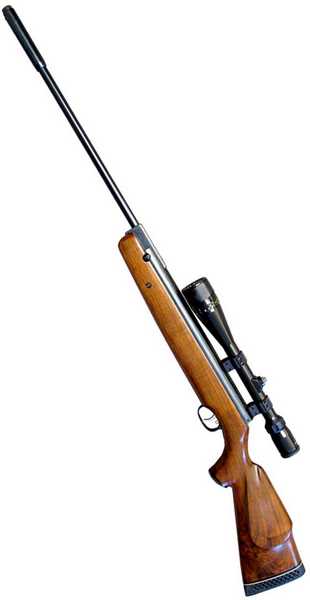
My 18 year-old Beeman R1 with its Maccari custom stock and Bushnell 6-18x Trophy scope is a thing of beauty.
Today, we’ll look at the accuracy of my Beeman R1 air rifle, and I must say that I remembered the rifle exactly as it is. It is very sensitive to hold, but also very heavy, at 11 lbs. in the test configuration, which stabilizes the gun to a great degree. Compared to the twitchy over-bore spring guns of today, shooting my detuned R1 is like driving an old family car!
I sighted-in with 15.9-grain JSB Exact domes because I thought they would turn out to be the best pellets. Even though they fit the breech loose, I felt they would surpass all other pellets. Let’s see how they did.
The distance is 25 yards, and I’m shooting from a rest, using a classic artillery hold where the back of my off hand touches the front of the triggerguard. I did try a group with a different hold, but it opened right away, reminding me that I know this rifle quite well.
The first group of JSBs contains a nice 8-shot group at the center of two shots that appear to be fliers. They aren’t fliers, though, because I held the rifle the same for every shot. It’s possible I didn’t relax enough for those two shots, which is why I say the R1 is sensitive to hold. As a powerful breakbarrel, you expect it to be hold-sensitive.
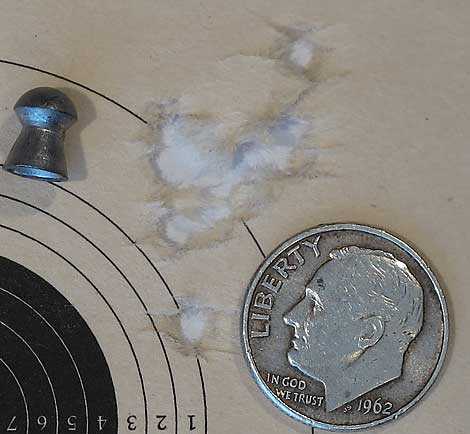
This first 10-shot group measures 0.978 inches between centers, but the smaller 8-shot group within measures just 0.38 inches. That’s quite a group for a spring gun at 25 yards!
The first group gave me some confidence in this pellet, so I adjusted the scope, shot a couple rounds to settle things and fired a second 10-shot group of JSB Exacts. This time, all 10 shots landed in a group measuring 0.642 inches between centers. My hold while shooting this group was more relaxed than the first.
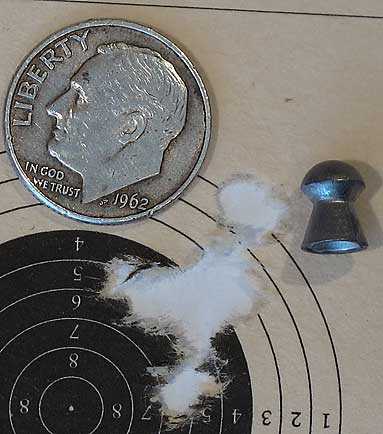
Ten JSB Exacts went into this group that measures 0.642 inches.
Next, I decided to try some Crosman Premiers. When this rifle was new in 1994, they were the best pellet on the market. Ten shots gave a very round group that measures 0.683 inches between centers. That’s ever-so-slightly larger than the second JSB group, so I feel these two pellets shoot about the same.
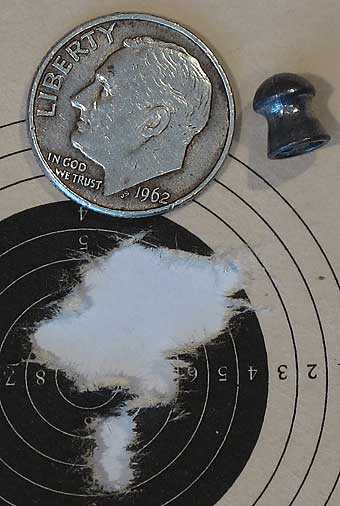
Ten Crosman Premiers made this 0.683-inch group.
I then tried the H&N Baracuda Match pellet that I don’t remember ever trying in my gun. I know they’re going slower — I can hear the amount of time the pellet takes to get to the trap. I didn’t know what to expect, but boy does my rifle like this pellet! The first 8 went into a very small group, then I rushed shot 9 and got a pellet outside the group. It wasn’t a flier, it was a mistake in technique, pure and simple. Shot 10 went into the tight group, and I ended with a group that measures 0.684 inches between centers, with 9 of those pellets in 0.54 inches.
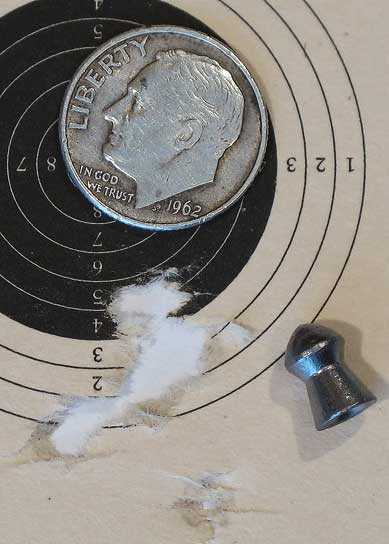
Ten H&N Baracuda Match pellets made this group. While it isn’t the absolute smallest, I feel it represents the best pellet in the rifle (of those tried).
Overall impressions
I feel the H&N Baracuda Match pellets turned in the best performance overall. So much so, that after the session ended I adjusted the scope so this pellet hits the point of aim at 25 yards.
The light, crisp Rekord trigger contributed a lot to the success of this rifle. It releases so well that the rifle isn’t affected by anticipation. Before I can hope for the gun to shoot, it already has.
The R1 recoils forward a lot. That’s due to the heavy piston. But most of the vibration has been eliminated. That’s something I wish the rest of you could experience. It’s so satisfying to shoot an air rifle like this because if feels so RIGHT.
What’s the bottom line, here? Well the R1 is still a fine spring air rifle with many classic features in its favor. Being a springer, it’s difficult to shoot well, but it’s capable if you do your part. It has one of the finest triggers on the market, and there’s nothing more I can say about that. But the R1 is also a very large rifle, and often I want something a little smaller so I can shoot all day without straining.
The tune that’s on the gun now is very light and easy to deal with. It makes the R1 feel like an R9 in all ways except size and weight. Now that the test is finished, this one will go back to the closet…but I know it’s sighted-in. If I call upon it in the future, it’ll do the job.
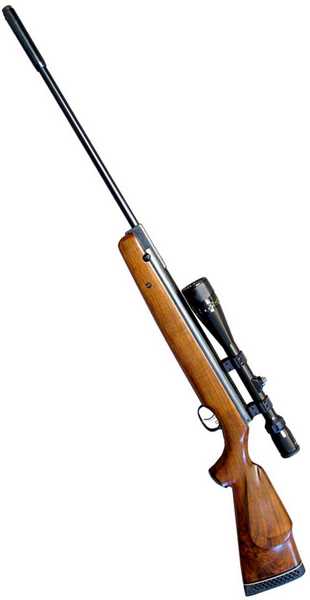
B.B.,
Do you plan on messing with the Vortek brake? Personally, I would love to see a fourth part, fine tuning the rifle another step.
-hm
hankmcrae,
I think I promised to test the Vortek muzzle brake adjuster for somebody already, so another test is on the schedule.
B.B.
B.B. My R1 must have been tuned. Picked it up from a Pawn Shop in Lousiana. What a sweetie ! Smooth as glass in .177. Low cocking effort ( vs OEM)…so I’m awed by the very low fps in your part one review plus the over the top ( for moi..) cocking effort. My Gamo BigCat beats that…in fps and cocking effort. Anyway, I always enjoy my first cup of java reading your wonderful reports, and I am sure I am not alone.
Thank you,
Pete
Pete,
B.B.’s R1 is .22 cal and doing 17-18fpe. The velocity seems ideal to me. Are you comparing the velocities of your .177 to his .22?
kevin
duh…Kevin, not reading carefully is a result of a brain vacuum at 83..thanks for the heads up !
But still think the cocking effort is over the top. Then again, you see my thinking capacity..
Pete
BB,
It looks to me like you have two fliers on every target. Did you have the hiccups during this test? Fantastic rifle! Makes one wonder, why doesn’t the industry make them all this way (rhetorical question).
-Chuck
Hello B.B. and Fellow Airgunners. First, let me wish you a safe journey and a productive and good time at the Leapers Co. Second, I want to second hankmcrae’s idea that you do one more part on this Vortek brake. Personally, I have never encountered one. I don’t believe too many of your readers have either. It would be very informative too see just how this Vortek effects the shooting characteristics of this beautiful R1. It would also be interesting to know how much the Vortek comes in to play concerning those great groups made by three different pellets. And how you tune it as well. So many questions.
Caio Titus
Titus,
Yes, I will test the Vortek brake in another report.
B.B.
Tom, just an idea for you to try….the Michael Jackson artillery hold…A customer noticed that his groups would open up in the afternoon when shooting and tried to figure out why, seemed to be friction. His skin was different in the pm and seemed to grip the stock a bit and open the groups up from his morning shoot, what to do? He waxed the bottom of the forestock and put a cotton glove on that hand, now the rifle would slide much smoother and his groups stayed the same from morning to afternoon and tightened up…just an idea to try
Mike,
The Michael Jackson artillery hold? Now I have heard everything.
Do I need to moonwalk, too? 😉
I will test it that way.
B.B.
B.B.
You moon walk and grab at your crotch after you shoot a fly with it.
twotalon
When I read the first of these reports on the R1 it reminded me that there has always been a velocity race in airguns. I seem to think of it as a modern phenomenon mainly fueled by Gamo but this is not the case. If it weren’t for this race for faster and faster flying pellets we would not have the FWB 124 and the R-1. Who knows what fine rifles will come from the current race for speed.
David Enoch
I guess I’m confused now about what is meant by a “flyer.” I thought is was a shot that went wild (i.e. out of group) for unknown reasons. And what is meant by a “called” shot; i assume that is a shot you know immediately the sear trips that you have not done your best.
john
Almost, John. A called shot is as you described, but you also know where it’s going to hit before it gets there. You can see where the sights are pointed as the gun discharges.
A called shot is also a shot deliberately taken at the side of the target, not the bull, after calling out your intention to do so. This is to start over with the process of loading, sighting, etc.when for whatever reason, the shot you’re getting rid of just isn’t working out right and you need to feel the complete process to get back on track.
Please correct me if I’m wrong BB, Victor, or any of the other competition nuts.
/Dave
john,
/Dave got it right. A flier is a wild shot for a known reason. When there is no apparently or known reason, we say the shot belongs in the group and it reflects the actual accuracy of the pellet.
B.B.
John,
I agree with what both you and /Dave define as a “called” shot. I’ve mentioned before that we used to practice “calling” shots where the non-shooter had the spotting scope and the shooter had to “call” (i.e., say where the shot went based on what they saw during their execution) the shot. I’ve always understood a “flyer” to be that wild shot that cannot be explained by the shooter because they saw a good solid execution. In other words, a “flyer” appears to indicate a guns lack of repeatable accuracy. As B.B. said, it belongs in the group (we just FEEL that it shouldn’t be counted as part of the group. : )~.
Victor
So what if you call a shot out and it ends up going in? Is that a good shot or a bad call? That has happened to me rarely.
Matt61
Matt61,
That’s a bad call and luck.
Victor
In a match, I call it just fine :)! Never happens when I really need it to though!
BG_Farmer,
In a match I’ve been both lucky and unlucky.
Victor
BB,
Do you think H&N 12.6 grain Baracuda Green are to light for your rifle? It would be interesting to see how they do if you have any.
caveman,
I will try to get some in time for the next test.
B.B.
I didn’t know that the classic artillery hold involved choking up on the off-hand so much that it touches the trigger guard. I would have guessed not to do this because of the extra contact which seems to defy the basic principle of the artillery hold. But I had never heard of the Michael Jackson artillery hold either.
Robert, how interesting about the accuracy of the 30-30. I’ve read so many articles about how the 30-30 was revolutionary in its time but a blooper by the standards of modern ballistics. And the 30-30 is often compared ballistically to the AK 47 round, the 7.62X39, which dies at 300 yards. So, I hadn’t though of it as accurate.
Kevin, what I really need is space and no one to bother me for the shotgunning which I don’t have. But I didn’t realize that you could actually use a trap thrower by itself. I’ll have to remember that. Those are dramatic stories about the drought, and you guys are doing a heck of a job keeping things under control. Do the coyotes wade into the water after the fish? I didn’t think they were fish eaters.
Matt61
Thing is, supporting at the trigger guard is also maximizing the unsupported region — sort of making everything in front of the hand “free floated” and allowed to bounce around.
Desertdweller,
I read your report with interest. I can’t argue with science although I think you should try the points one more time with reduced holdover. Don’t waste a lot of time on it though, as it is just a hunch.
You went to such effort that I was inspired to re-create a bit of my favorite “sporting course” (I call it “plunking”) for your enjoyment; its a combination of FT and woodswalk. It is offhand and open sights only (thus the large targets, for me anyway :)), so a little different, but I knew what you went through!
Here is a “lane” (’bout time to really mow that slope) with LARGE coffee can on fiberglass post at 50 yards (approx.) from camera/shooting position.
https://lh5.googleusercontent.com/-yCPNSHcxa8g/UDazYz2_uNI/AAAAAAAAAqI/k2kTnc7uZ6w/s800/plunking50y_easy.jpg
With the currently somewhat ailing 36-2 and the hunting points, this is not a hard shot, but there wasn’t much wind. When I did it regularly a couple of years ago, there was a soup can and a small tomato paste can at same distance which were very challenging, nearly impossible (every time with the paste can) to hit. However, when I used 75 and 100 yards, the coffee can became enough of a challenge; I can’t claim to have been very good at all at 100 with the can (maybe 1/10 if that?). Currently there are critters in a pasture/paddock up and to the left, so I cant use the 100 yard “angle” I generally use for a while, but I know right now I couldn’t hit it at all without working up to it some :). Anyway, 100 yards is a long way for a springer!
Oh yes, that looks good!
I like the “woodswalk”. Our range is built along the South Platte River on the floodplain. Bare of vegetation (killed with weed spray) and a mixture of sand and river rock: essentially a strip of desert.
The backstop is a tall berm of sand, with a row of railroad timbers projecting out about halfway up to contain ricochets.
The wooden target frames are made from 2×4 and 4×4 timber, with slots to hold 2×4′ blackjack panels.
Targets are pinned to the backers with a staple gun or push pins. Shooting benches hold two shooters each, and are located at 50; 100, and 200 yard distances. Halfway between the 50yd. bench and the target frames is a simple table made from 2×4 and 4×4 lumber. It is to hold targets at 25yds.
The next time I try shooting at 100yds. I’ll try a heavier pointed pellet. I just think the 7.4gr. pellet was too light to be stable at that distance. I’m sure the XT could deliver a heavier pellet at that range.
I’m planning to go back tomorrow, weather permitting, to shoot at 25 yards. I’ll test out the 880 I repaired and my 856. I’m bringing the XT as a backup. The kids are in school, so I can take my time by myself.
I use the range more than anybody, including law enforcement. Next year I plan on being Range Manager.
Today I bought Amber (the youngest one) a Daisy 1998 bb gun. It is like a Red Ryder, but with a pink painted stock. She is going to start bb gun school in January, so will get some practice in this fall.
For her, I set targets at 15 feet. She has practiced at that range with my Red Ryder and Marlin Cowboy. When she masters that, I’ll get her a Crosman 760 like her brother and sister each has.
I always keep a notebook when I shoot, and have taught the kids to do the same. I knew I would be posting the results, so I kept more detailed notes than usual.
I’ll try that coffee can idea next time I shoot at 100 yards. For now, I shoot Shoot-N-C 6″ targets at 25yds. I shoot 30 rounds and score the target for points against a possible 300. This gives me a consistent standard I can rate myself against. My grandkids are getting to the point where the older two can shoot pretty well with the 856 or the Bronco at that distance. I score their targets and record the scores in their notebooks, along with gun used and pellets used.
The idea is to create a repeatable standard they can record their scores with a variety of guns, and see how they improve with practice.
Les
Good jobs with the grandkids.
I don’t know about the weight of the points lately; I remember they changed them at some point. I think the ones I have are 7.9gr. or that is my memory — they came in big cartons like school milk, and I’m still using them when appropriate, have several thousand left (it wasn’t a huge investment) :).
For the long ranges, do you have Chairgun (now “Hawke Chairgun Pro”)? I think it can be very useful to give you some ideas what to expect at longer ranges, even windage/drift. I don’t know if it is 100% right on all the time, but it is better than nothing, and the predictions seem to agree pretty well with reality much of the time.
I am watching a Military Channel program about the Army Sniper School. It said the rotation of the earth has to be taken into account for long shots.
Dang! I plum forgot to do that when shooting at 100 yards. Wonder how to correct for that?
Les
Hi, I bought the hw 80 (beeman r1) today. Any tips for accuracy?
7 of the 10 shots are spot on…..the other 3 seem to swerm a 1/4 inch off the point of aim.
Thanks
Nb: I secured all the screws, put my hand on the beanbag, soft toutch witch cheek
dutchjozef,
Welcome to the blog.
What pellet are you using, what caliber is your gun and how far are you shooting?
B.B.
Hi, Im Shooting jsb exact 15.89 grain .22 caliber…..at 25 yards
Im a former 3 positions champ with rimfire and a 10m airgun meddal winner. ButI know this is an other ballgame, so all the help is welcome.
I dont expect the same results as with my 1976 fwb 300s. … but I know I can do better with the hw80
Thanks
dutchjozef,
That would have been one of the pellets I would have recommended. Also Crosman Premiers and Beeman Kodiaks/H&N Baracudas.
The R1 is a twitchy breakbarrel to shoot accurately, so why don’t you experiment with off hand placement. Usually having the heel of your hand touch the triggerguard is best, because it gives you muzzle heavy-ness. But you might try sliding the hand out to the beginning of the cocking slot and see what that does.
I assume your rifle isn’t tuned yet? So it vibrates a little when it fires? The soft hold is so critical with an R1 in that condition. Remember to not pull it into your shoulder, either. Let it buck and roar all it wants.
B.B.
One final thing. Is the barrel joint tight enough? After you cock the rifle will the barrel stay where it’s put, or does it fall back down when you release it? If the latter, the pivot joint needs tightening.
B.B.
Yes, indeed the rifle isnt tuned. It vibrates, but less as a hw97k or a hw85. It has more of a massive thump.
My trigger hand placement: thumb at 12 o clock, just under the 30mm tube.
Loose grip with hand. No jerking with my trigger finger….but gently building up the pressure.
Its dark here now, but ill try your suggestions.
I DO make contact with my shoulder….not as much as one would do as with a lee enfield 30-06, but its a persuasive pressure that I apply. Ill try to loosen my shoulder pressure.
So….
Resting the stock in the inside of my hand (like 10m Olympic)
Soft check pressure
Soft shoulder pressure
Shooting hand soft toutch
Ok heres an update. I removed the scope (hawke 3-9×50 *sportsmatch 1piece) and shot with the irons.
Best I can do is about 10 or 12 milimeter at 18yards.
I always shot peepsights….so its different.
25 milimeter is one inch. But I have no idea if this is good, acceptable or bad??
I thing I notised, without the scope….. the gun moves more naturally, more in harmony.
Its like the gun Wants to be shot with irons.
Im now considdering to make this my unscoped rifle. My hw85 is scoped, my custum fwb300s is also scoped.
At short range….25 yards maximum, I use the 300s for hunting crow and pigeon.
Im now considdering to make the hw80 my point hunting rifle….unscoped.
–do you think thats a good idea? Hunting with irons?
Any experience using irons over 30 yards??
I guess id would give me a pointblanck range from 17 to 35 yards.
dutchjozef,
10 to 12 mm at 18 yards is very good for a .22 HW 80! I would be happy with it.
Are the fliers no longer a problem with the open sights?
II think a rear peep sight would bring you down to 8 mm at that distance.
I have zero experience with open sights on airguns beyond 30 yards, but I shoot a lot with firearms at 100 yards with peep sights. My best so far is 10 shots under two inches but I would hope to someday be able to put 10 into 1/2 inch at 100 yards. I am working on it with a Ballard rifle that was made in 1886.
/blog/2011/03/the-art-of-collecting-airguns-part-8/
B.B.
Okay thanks! I didnt know if I was on the right track or not. The rifle comes with different insert pieces. I even tried the round ones with the tiny hole in it. Works great on Olympic 10m cards on 18 yards.
The odd flyer is gone when shooting without scope.
I expect to get better shots in the future. I only shot 500 pellets sinds yesterday.
The thing I notice: with +16 footpounds I often tend to make a mistake:
A lot of shots are spot on…..and then the pellet hits LEFT. Im sure its my mistake….but I cant seem to findout what I did wrong. Aswel with the 80 scoped, 95 scoped and 85 scoped …..when I mis….I miss on the left side. Maybe a triggerfinger error? Do you have any Idea?
As to your aim for 0.5 inch groupes: you might wanna try an Anschutz .22. At 45 meters you Easily shoot thumbnail groups. So at 90 meters (100yards) sub inch groups are possible.
You know “a thing or two” :).. about the r1. Sinds the hw80 is basiclly the same rifle….can you tell me how the break barrel joint will effect accuracy in the long term? I shoot my air rifles a LOT. Im curious how the joint preforms after 10 or 50 thousands shots.
dutchjozef,
My R1 now probably has 15,000 shots on it. It’s the gun I used when I wrote the book. The breech joint is still tight and looks like it will be so for a million shots or more. I lube the thin spacers with moly grease and also the pivot bolt, and keep the joint tight.
Shots going to the left? Are you a right-handed shooter? I think the problem may be in your hold. If your off hand isn’t flat, any place it touches the stock will interrupt the vibration patterns and attenuate them, so the pellet exits at a different place.
The artillery hold is about timing. Since the pellet always exits at the same time after the shot, the goal is to put the muzzle in the same place at that time, every time. Letting the gun vibrate and move the way it wants to helps regulate where the muzzle will be.
B.B.
Im right handed. The off hand is the hand that applies the artillery hold? The hand that holds the stock?
Okay ill dig in to that.
I used to know all these things…. about finding error patterns…. but I forgot them. Trigger finger error has its own side….. but I cant seem to remember
dutchjozef,
Here is a video and short article on the artillery hold.
/article/The_artillery_hold_June_2009/63
B.B.
Thanks!!
Point blank range…..
Ive sighted in at 15 meters ( approx 17 yards).
Am I right, with irons, this will give a PB range from about 14 to 30 yards?
If so….. id be delighted.
Ok. I now have figured out the optimum way to shoot tight groups.
Instead of resting the stock on my palm… I use an adoptation of the artillery hold.
I put my middle finger length wise in the gap for the cockingleaver.
My pointing finger left of the middelfingef.
My ringfinger right of my middle finger.
The 2 outside fingers stabilise the stock.
All 3 fingers are stretched…so my palm Does Not touch the stock.
Cos you put your middle finger in the gap….youll always have the same spot where you put your fingers.
The hold is almost the same as the standing position hold for 10 meter airrifle.
My shoulder does Not touch the shoulder pad….only my cheak touches the end of the stock.
I dont know if I can post pictures here….but maybe that will explain my hold.
The accuracy is no problem any more….using this hold.
Ive put the scope on today and drew a cross with a 2milimeter marker.
At 22 yards I can now put the pellets on the horizontal and vertical 2mm stripes.
This is benchrested and using h&n ftt 5.53mm.
These pellets are more accurate than the jsb in my bore.
dutchjozef,
You are now officially an airgunner! Remember last month when you wondered why your marksmanship skills hadn’t carried over to airguns? Now you can teach others how to shoot them!
Congratulations!
B.B.
There is a very special and extremely rare HW 80/R1 that was tuned under the guidance of a British engineer called Mike Wade going back in the 80/90′s that produced 23/24ft/lb of energy in .22 with a very fast action and acceptable recoil that made it very accurate without putting in one of the monster springs you can get today and this was achieved with a standard but sized piston head. The gun shot with a slight nudge to the shoulder. I will say this, until you have shot one of these your journey with the R1/HW80 is not complete.
Thanks for the induction!!
Shooting 800 pellets with iron sights helped ALOT!!
The irons gave me “the feel” for the rifle.
There is a very special and extremely rare HW 80/R1 that was tuned under the guidance of a British engineer called Mike Wade going back in the 80/90’s that produced 23/24ft/lb of energy in .22 with a very fast action and acceptable recoil that made it very accurate without putting in one of the monster springs you can get today and this was achieved with a standard but sized piston head. The gun shot with a slight nudge to the shoulder. I will say this, until you have shot one of these your journey with the R1/HW80 is not complete.
As you stated, its a rare item. So theres no chance getting my hands on one of them.
Ive had a little journey with my hw80. It now carries an Anschuetz diopter with an adjustable iris-opening/adjustable peep-opening. This now allows me to hunt and practice in low light conditions.
By now Ive come to know my hw80 very well. With my fwb300s I can shoot 120 points of a total of 120 points at Olympic 10m.
—comparison:–
My hw80 will shoot an avarage of 116/117 points of a total of 120 points…. so thats 3×9 points and 9×10 points. Its THAT accurate.
The stance: the good old Olympic standing style stance and hold. Thats what im familiar with, and works best for me.
I do believe that my hw80 is a “hot” one, Ive tried all of the hw80’s my gunsmith had. ….. this one had the best report/ feedback. It shot most smoooooth of all them guns, but still delivers 20 fp/26 joules.
—Thanks for your comment